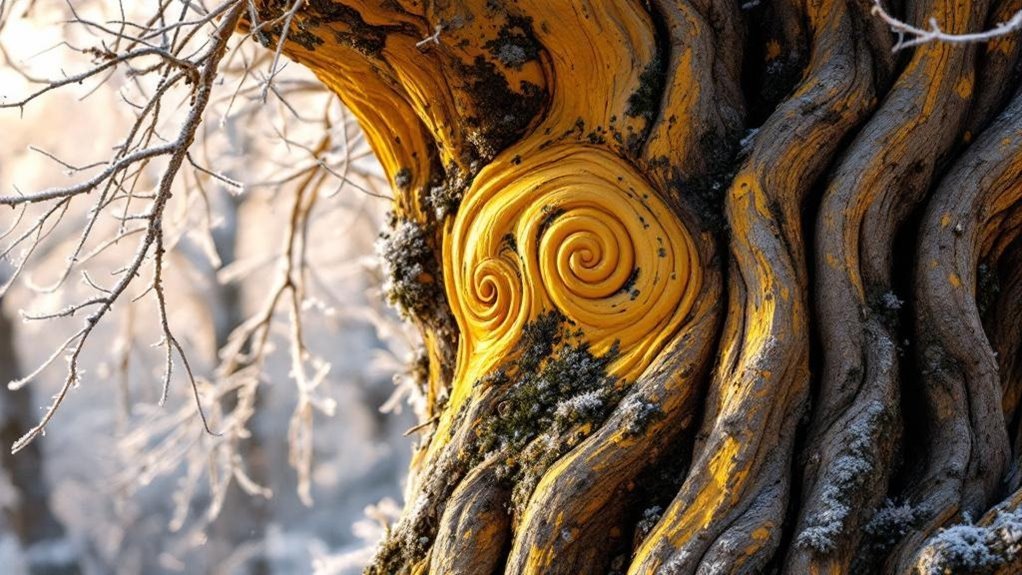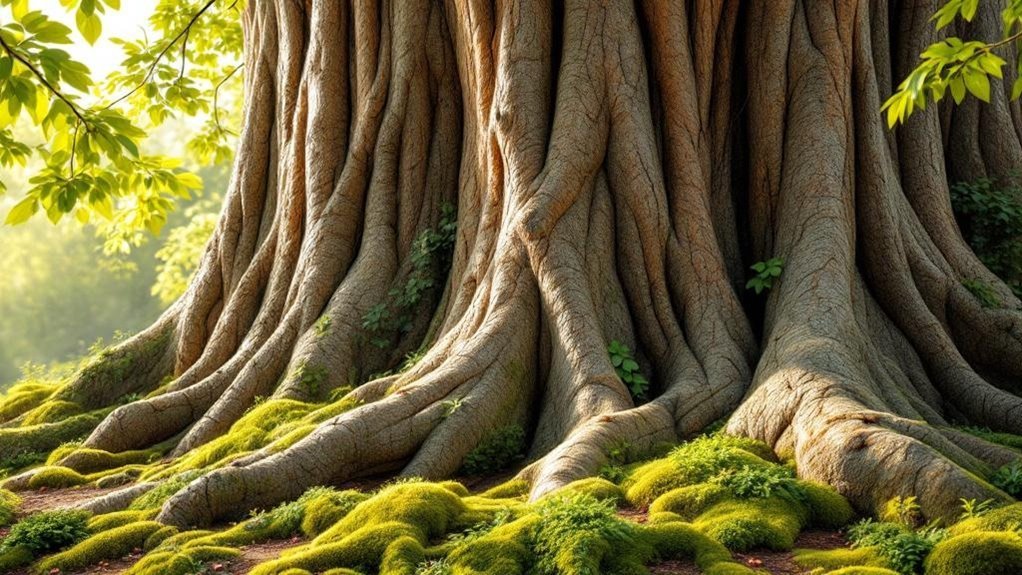You might think trees are only worth noticing when they’re covered in leaves or blossoms, but their bark can offer just as much visual interest throughout the year. When you start paying attention to bark’s textures and colors, you’ll find a whole new layer of beauty in your landscape. From striking whites to rich reds and unusual patterns, these trees can transform your outdoor space in ways you might not expect.
White Bark Trees and Their Unique Qualities
Although you might first notice their striking white bark, trees like the Silver Birch and Himalayan Birch offer more than just visual appeal. Their luminescent white bark acts as a natural shield against sun damage and UV radiation.
The peeling bark of the Himalayan Birch reveals a yellowish underlayer, adding seasonal interest alongside its lime green spring leaves and golden autumn hues. Silver Birch supports over 300 insect species and various birds, boosting biodiversity in its habitats.
Himalayan Birch’s peeling bark and seasonal colors enrich landscapes, while Silver Birch enhances biodiversity with its insect and bird support.
Similarly, Paper Birch not only captivates with its white bark but also attracts pollinators through its catkins, contributing to ecosystem health.
These white bark trees stand out dramatically in morning light and provide beautiful contrast against evergreens in winter, making them a valuable addition to any landscape.
Vibrant Red and Coral Bark Varieties
Two standout trees with vibrant red and coral bark can instantly brighten any winter landscape.
The Coral Bark Acer, renowned for its dazzling coral bark, offers year-round interest, especially when cold weather intensifies its unique coloration.
Red-bark varieties like the Coral-Bark Maple add visual interest with delicate leaves shifting from bronze-green to crimson in fall.
These trees serve as eye-catching focal points throughout seasons.
Here’s why you should consider them:
- Vibrant red bark stands out vividly against winter whites.
- Coral bark provides striking contrast and texture.
- Tannins in bark protect against pests and sun damage.
- They enhance both residential gardens and public parks.
Yellow and Golden Bark Trees for Winter Color

When winter strips most trees of their color, yellow and golden bark trees stand out by adding warmth and brightness to the landscape. Their unique coloration creates striking focal points in winter gardens, offering contrast to muted colors. The Golden weeping willow, with its vibrant yellow bark, especially shines after winter pruning, enhancing overall vibrancy. Other species like Hutchinson’s Yellow willow and Cornus stolonifera ‘Flaviramea’ contribute bursts of yellow bark, boosting aesthetic value and visual interest. Incorporate these trees to transform dull winter scenes into lively displays.
| Tree Variety | Bark Color |
|---|---|
| Golden weeping willow | Bright golden |
| Hutchinson’s Yellow willow | Soft yellow |
| Cornus stolonifera ‘Flaviramea’ | Lemon-yellow |
| Golden Ness willow | Warm yellow |
| Winter garden focal points | Yellow bark hues |
Textures and Patterns in Tree Bark
If you pay close attention to tree bark, you’ll notice a fascinating variety of textures and patterns that bring the landscape to life. Bark isn’t just a protective layer—it offers interesting textures that add visual interest year-round.
Consider these examples:
- Peeling bark on Paperbark Maple reveals contrasting inner layers, creating dynamic patterns.
- White bark on Himalayan Birch becomes increasingly fissured with age, adding depth.
- Shaggy bark on Shagbark Hickory forms unique, tactile patterns that stand out.
- Seasonal changes bring color shifts and raised lenticels, especially visible in winter.
These diverse bark textures and patterns transform any tree into a living artwork, inviting you to explore and appreciate nature’s subtle details all year long.
Selecting and Placing Trees With Ornamental Bark

Although selecting trees with ornamental bark requires thoughtful consideration, you can create stunning visual interest year-round by choosing species like Paperbark Maple, Himalayan Birch, and Coral Bark Maple. When placing trees, consider their growth habit and final size to enhance landscape aesthetics effectively. Position them along pathways or open lawns to showcase their colorful bark and maximize year-round interest.
| Species | Key Feature |
|---|---|
| Paperbark Maple | Cinnamon-colored peeling bark, vibrant autumn foliage |
| Himalayan Birch | Radiant white bark, striking winter presence |
| Coral Bark Maple | Bright coral-colored bark, seasonal foliage changes |
| Betula nigra | Fast-growing, exfoliating bark, thrives in moist areas |
Frequently Asked Questions
What Are the Different Tree Bark Textures?
You’ll find tree bark textures ranging from smooth and shiny to rough and furrowed. Some bark peels or exfoliates, while others feature warty or polished surfaces, offering vibrant colors and tactile variety throughout the year.
What Is the Best Dwarf Tree to Plant Next to a House?
You’ll want a dwarf tree like the Creeping Blue Spruce or Dwarf Korean Lilac next to your house. They stay compact, add beauty, and won’t overwhelm your space or damage your foundation with their roots.
What Tree Has Bark Like Paper?
You’ll love the Paperbark Maple if you want bark like paper. Its cinnamon-colored bark peels beautifully, revealing vibrant orange-red layers underneath, adding year-round texture and color to your garden with minimal care.
What Tree Has Very Smooth Bark?
You’ll find very smooth bark on trees like the Paper Birch and Himalayan Birch, both showcasing striking white, smooth surfaces. Crape Myrtle and Shining Bark Maple also have smooth, peeling bark that adds year-round interest.
Final Thoughts
Isn’t it amazing how trees with interesting bark can transform your outdoor space all year long? By choosing varieties like the Paperbark Maple, Himalayan Birch, or Shagbark Hickory, you’re not just adding color—you’re introducing texture and character that change with the seasons. So, why settle for ordinary when you can create a landscape that invites touch and admiration every day? Embrace these unique barks and watch your garden come alive.
